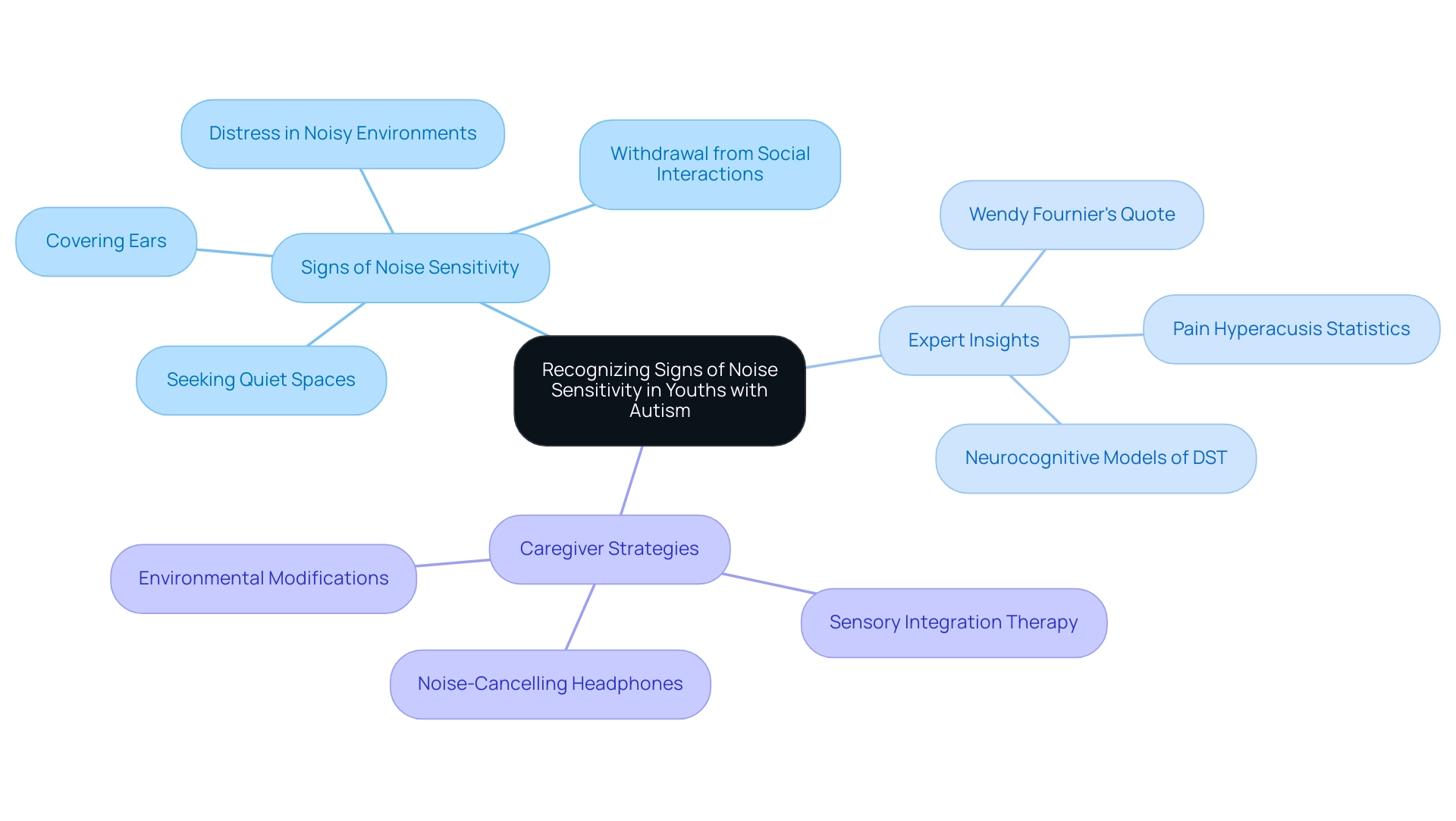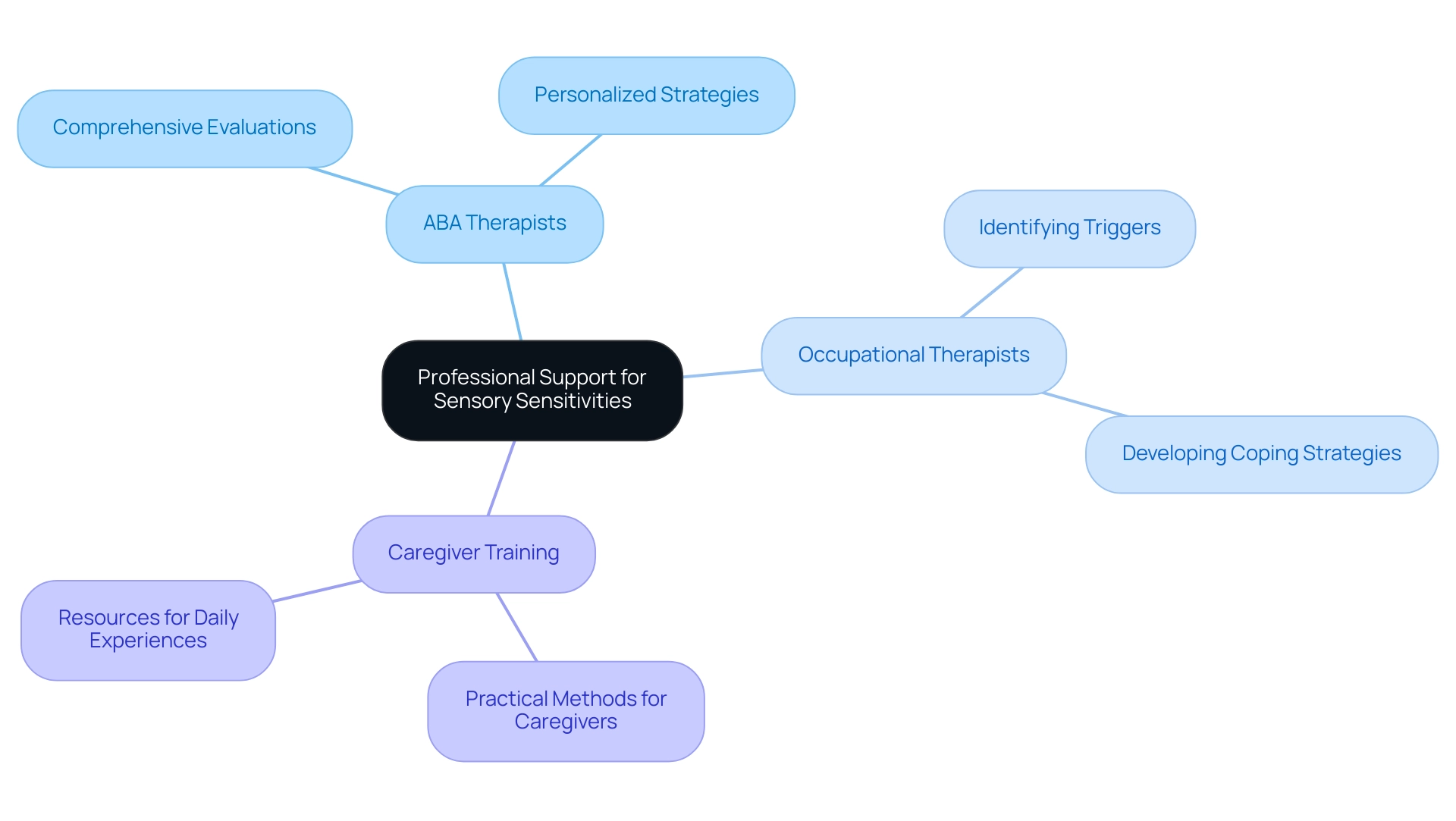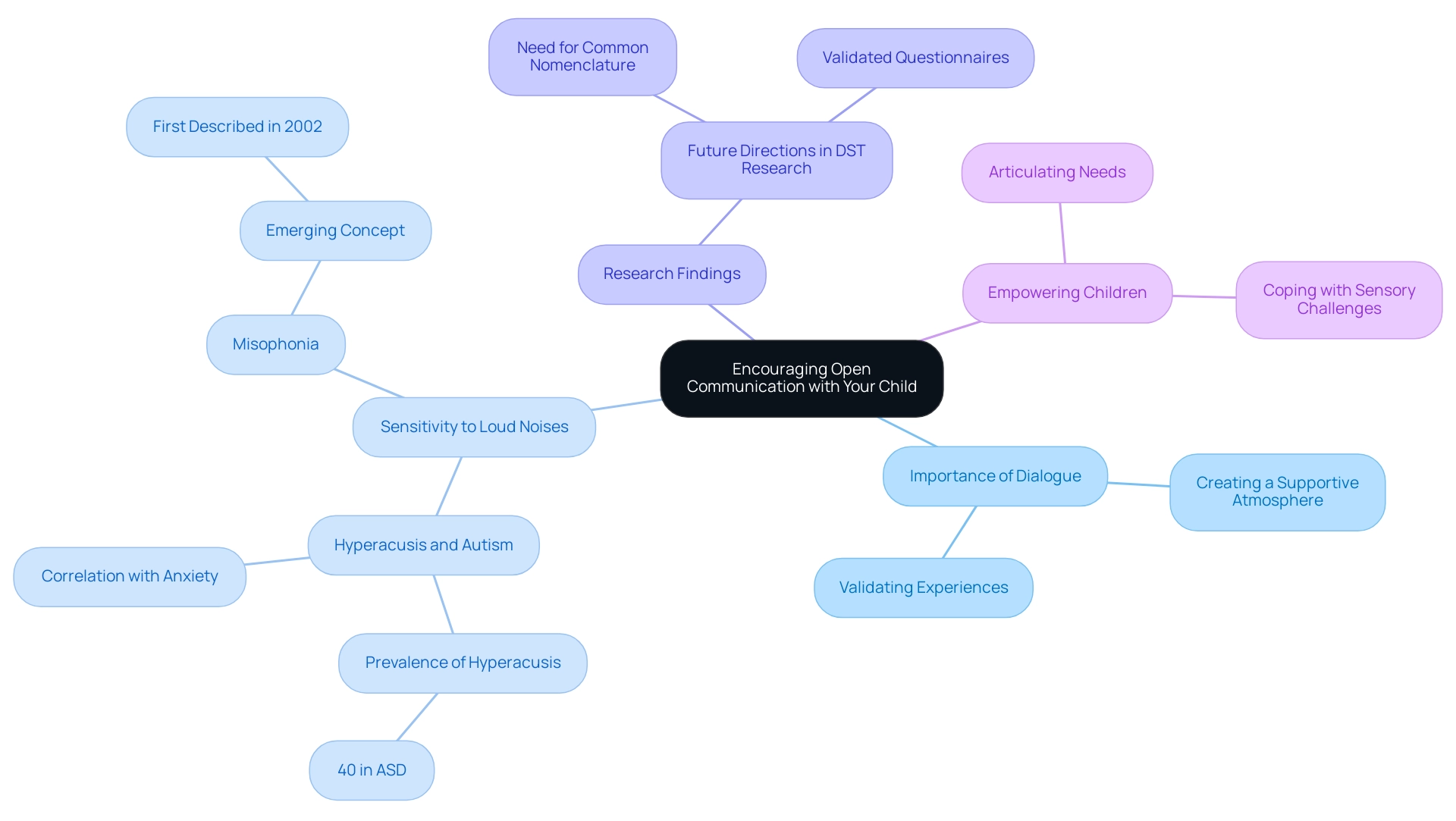Overview
Sensitivity to loud noises can indeed be a sign of autism, as many individuals with autism spectrum disorder (ASD) experience heightened auditory processing, leading to discomfort or distress in noisy environments. The article supports this by detailing research findings that indicate a significant prevalence of auditory sensitivities among those with ASD, alongside practical strategies for parents to help manage these sensitivities and improve their children's well-being.
Introduction
Navigating the world of autism can be a complex journey, particularly when it comes to understanding noise sensitivity—a prevalent yet often overlooked aspect of autism spectrum disorder (ASD). For many children with ASD, everyday sounds can become overwhelming, transforming familiar environments into sources of anxiety and distress.
This article delves into the intricacies of noise sensitivity, offering insights into its impact on daily life, practical strategies for management, and the vital role of professional support.
By recognizing the signs and fostering open communication, parents can empower their children to navigate their sensory experiences more effectively, ultimately enhancing their overall well-being.
As the understanding of these challenges evolves, so too does the opportunity for parents to advocate for their children's needs, creating a more supportive and inclusive environment.
Understanding Noise Sensitivity in Autism
A prevalent characteristic among individuals with autism spectrum disorder (ASD) is their noise responsiveness, which raises the question: is sensitivity to loud noises a sign of autism? Many people wonder, is sensitivity to loud noises a sign of autism, as it can vary widely—from discomfort with loud sounds to an overwhelming urge to escape from bustling environments? For parents, comprehending this facet of autism is vital not only for identifying signs but also for fostering supportive surroundings.
Recent studies emphasize that individuals with ASD often exhibit impaired temporal resolution in processing auditory stimuli, necessitating longer intervals in gap detection assessments. This heightened auditory processing can lead to increased awareness of frequencies and volumes, prompting the question: is sensitivity to loud noises a sign of autism, which can contribute to anxiety, stress, or even meltdowns in response to sudden or loud noises? Significantly, 10.1% of the heterogeneity in prevalence estimates of noise reactions is attributable to age, indicating variability in how children experience these reactions.
As Wendy Fournier, President of the National Autism Association, observes,
We’re hoping that, with the data collected, it will lead to the development of devices that could help alleviate auditory sensitivity and the discomfort that accompanies it.
Furthermore, a study on hyperacusis in individuals with ASD reveals that its prevalence exceeds that of many major mental disorders, highlighting an urgent need for research to develop effective behavioral or pharmacological treatments. These findings underscore the pressing need for ongoing research to develop targeted interventions.
Additionally, healthcare providers must assess and accommodate decreased sound tolerance throughout the lifespan of individuals with ASD. By recognizing and addressing these auditory triggers, parents can play a crucial role in mitigating the challenges their offspring face, thus enhancing their overall well-being.
The Daily Impact of Noise Sensitivity on Individuals with Autism
The daily lives of individuals with autism are profoundly influenced by noise sensitivity, leading to significant challenges and prompting the question: is sensitivity to loud noises a sign of autism? For example, schools, bustling restaurants, and crowded public transportation can quickly become overwhelming due to unexpected loud sounds. Research indicates that individuals with autism frequently struggle to concentrate in classrooms where background noise distracts from learning, with studies showing that noise levels in schools can significantly hinder their educational experience.
In fact, the ASD group evaluated a tone with an arousal score of 5.27 (SD = 0.3) and a siren with an arousal score of 4.97 (SD = 0.3), demonstrating the increased awareness many young individuals experience. Furthermore, social situations filled with multiple conversations can trigger anxiety, making outings with family a complex endeavor. As noted by expert ZJW, "[insert relevant quote here]," which emphasizes the need for awareness of these sensitivities.
Parents frequently find themselves evaluating noise levels at different locations to ensure a comfortable experience for their offspring. The case study titled 'Clinical Implications of Hyperacusis in ASD' highlights the prevalence of hyperacusis in individuals with ASD and raises the question, is sensitivity to loud noises a sign of autism?, emphasizing the necessity for further research and the importance of accommodating this condition. By understanding these impacts, caregivers can proactively plan ahead, create sensory-friendly spaces within their homes, and advocate for necessary accommodations in public settings.
Such measures not only foster a sense of safety and support for their offspring but also enhance the overall family experience in day-to-day life.
Recognizing Signs of Noise Sensitivity
Identifying signs of noise sensitivity in youths with autism is crucial for parents who wonder, is sensitivity to loud noises a sign of autism, as they aim to support their offspring's well-being. Common indicators, such as covering their ears during loud events and visibly distressing reactions in noisy environments, raise the question: is sensitivity to loud noises a sign of autism? Additionally, young individuals may withdraw from social interactions or actively seek out quiet spaces to escape overwhelming stimuli.
Wendy Fournier, President of the National Autism Association, highlights the significance of comprehending these behaviors, stating,
We're hoping that, with the data gathered, it will lead to the creation of devices that could assist in alleviating auditory discomfort and the distress that accompanies it.
This data is important as it could guide future measures aimed at reducing auditory discomfort in autistic children. Recent literature highlights that pain hyperacusis can occur at levels significantly lower than 120 dB SPL, underscoring the need for attentive observation.
Furthermore, case studies on neurocognitive models of Distress Sensitivity to Tones (DST) suggest that both low-level auditory processing disturbances and strong emotional reactions to sounds may play a role in these sensitivities. To assist their offspring effectively, guardians can consider strategies such as:
- Sensory integration therapy
- Utilizing noise-cancelling headphones or earplugs
- Making environmental modifications
By recognizing these signs and employing these strategies, caregivers not only gain insight into their offspring's unique experiences but also equip themselves to advocate for necessary adjustments in their environments.
Through a combination of behavioral indicators and expert guidance, caregivers can nurture a supportive environment that addresses their offspring's sensory requirements.

Strategies for Managing Noise Sensitivity
Addressing noise awareness in youngsters with autism necessitates a comprehensive strategy that enables parents to establish a nurturing environment. Approximately 70% of individuals with autism experience some degree of auditory sensitivity, leading to the inquiry: is sensitivity to loud noises a sign of autism? One of the most effective strategies is to establish a sensory-friendly environment at home.
Employing noise-canceling headphones or auditory machines can greatly reduce discomfort and enable youngsters to participate in their activities more comfortably. Gradual exposure to varying sound levels in controlled settings can also help foster tolerance, enabling young individuals to adapt to different auditory stimuli without overwhelming stress. Another essential aspect is the incorporation of a 'quiet time' routine, where youngsters can unwind in a designated calm space after being in noisy environments.
This practice not only aids in emotional regulation but also reinforces a sense of security.
Working together with educators is crucial for managing noise awareness within the classroom. By collaborating to establish a nurturing learning atmosphere, caregivers can ensure that their offspring's sensory needs are acknowledged and met. As AB Tabba observes, hyperacusis, which is a common form of auditory responsiveness in the autism spectrum disorder (ASD) population, leads to the inquiry of whether sensitivity to loud noises is a sign of autism, and it can frequently coexist with other medical issues such as:
- post-traumatic stress disorder (PTSD)
- depression
- migraines
- tinnitus
- hearing loss
- attention deficit hyperactivity disorder (ADHD)
- other sensory processing challenges
Grasping these complexities, along with continuous investigation into the causes and mechanisms of sound responsiveness, can assist parents and educators in applying more effective strategies tailored to each individual's unique challenges. Insights from case studies, such as those examining the link between temper tantrums and autism, can provide real-world examples of behavior management strategies that may also assist in addressing noise responsiveness. By promoting an understanding of sensory awareness, we can collectively advocate for healthier, more inclusive surroundings for our youth.
The Role of Professional Support
Interacting with specialists, like ABA therapists and occupational therapists, is crucial for effectively addressing the issue of whether sensitivity to loud noises is a sign of autism in individuals. These specialists perform comprehensive evaluations that identify a young person's particular sensory requirements and difficulties, as noted in an unpublished study involving 243 individuals with self-reported hyperacusis, which suggests that sensitivity to loud noises is a sign of autism. By crafting personalized strategies, they can address these sensitivities in a meaningful way.
For example, the case study on occupational therapy approaches illustrates how therapists work to identify triggers and develop strategies for youth to cope with sensory overload. Moreover, numerous therapists offer caregiver training sessions, equipping guardians with practical methods and resources to assist their offspring's daily experiences. This collaborative effort among ABA therapists, occupational therapists, and other professionals ensures that parents are equipped with the latest research and evidence-based practices, fostering an informed advocacy approach for their offspring's needs.
As noted by Brighter Strides ABA, the effect of sound discomfort on daily life and well-being can lead to social isolation and a reduced quality of life, prompting the question: is sensitivity to loud noises a sign of autism? Therefore, establishing a robust support network around the young individual is crucial for enhancing their overall quality of life.

Creating a Supportive Community
Building a supportive community is crucial for caregivers dealing with the complexities of noise sensitivity in individuals with autism. Participating in local support groups, online platforms, or social media communities provides invaluable connections with other caregivers who understand similar struggles. These environments not only facilitate the sharing of resources and coping strategies but also provide emotional reinforcement during challenging times.
For example, the establishment of support groups for caregivers has shown effectiveness in lowering anxiety and stress, with statistically significant variations observed in a recent study involving 24 guardians, including those with youngsters diagnosed with Autism Spectrum Disorder (ASD) and Attention Deficit Hyperactivity Disorder (ADHD). Laurie, a participant in this study, shared,
He was determined to help my son have a better life than he did and he gave me great insight,
reflecting the profound impact of shared experiences. It is important to note that the study's lack of a control group highlights the need for further research in this area.
Furthermore, engaging in community events dedicated to autism awareness helps promote understanding and acceptance, contributing to a supportive atmosphere for both individuals with autism and their families. By actively participating in these initiatives, parents can cultivate a more inclusive environment that uplifts everyone involved.
Encouraging Open Communication with Your Child
Encouraging open dialogue with young individuals about their experiences is essential, especially when discussing whether is sensitivity to loud noises a sign of autism? Guardians can establish a supportive atmosphere where young ones feel secure to share their emotions and worries regarding noises that trouble them. By asking simple, insightful questions like, 'How did that sound make you feel?'
Guardians can initiate meaningful discussions that provide clarity on their offspring's perspective. This type of dialogue not only validates the experiences of young individuals but also empowers them to articulate their needs in various situations. Promoting this communication assists parents in preparing their children to handle their feelings more effectively.
Recent research highlights the correlation between sensory hyperreactivity and anxiety symptoms in autistic individuals, which prompts the question: is sensitivity to loud noises a sign of autism? Notably, a pilot study conducted in 1995 reported a 40% prevalence of hyperacusis in those with ASD, which leads to the question, is sensitivity to loud noises a sign of autism? Furthermore, Jastreboff & Jastreboff observed that 'compared with hyperacusis, misophonia is a relatively new concept,' which further demonstrates the evolving understanding of sensory responses.
Furthermore, the case study titled 'Future Directions in Research on Decreased Sound Tolerance (DST) in Autism' highlights the need for a common nomenclature and validated questionnaires to better inform caregivers about the complexities of sensory sensitivities in autism, including the question of whether is sensitivity to loud noises a sign of autism? By fostering open dialogue, parents can significantly enhance their child's ability to cope with sensory challenges and advocate for themselves in different environments.

Conclusion
Noise sensitivity is a significant aspect of autism spectrum disorder that profoundly affects daily life for many children. Understanding the nuances of this sensitivity is crucial for parents as they navigate the complexities of their child's experiences. From recognizing the signs of discomfort to implementing practical strategies for management, parents can play an instrumental role in creating a supportive environment that promotes well-being.
By fostering open communication with their children, parents empower them to express their sensory needs and experiences. This dialogue not only validates their feelings but also equips children with the tools to advocate for themselves in various settings. Collaborating with professionals further enhances this support, allowing for tailored strategies that address individual challenges and promote a sense of security.
Building a nurturing community through local support groups and online platforms offers additional resources and emotional reinforcement, creating a shared understanding among families facing similar challenges. As awareness and advocacy grow, parents can effectively champion their children's needs, paving the way for a more inclusive and accommodating world.
Ultimately, recognizing and addressing noise sensitivity is not just about managing discomfort; it is about enhancing quality of life and fostering a sense of belonging for children with autism. Through informed advocacy and a commitment to understanding their children's unique sensory experiences, parents can make a profound positive impact on their lives.
Frequently Asked Questions
Is sensitivity to loud noises a sign of autism spectrum disorder (ASD)?
Yes, sensitivity to loud noises is a prevalent characteristic among individuals with ASD, and it can vary from discomfort to an overwhelming urge to escape noisy environments.
Why is understanding noise sensitivity important for parents of children with autism?
Understanding noise sensitivity is vital for parents to identify signs of autism and to create supportive environments that accommodate their child's needs.
What recent studies reveal about individuals with ASD and their auditory processing?
Recent studies indicate that individuals with ASD often have impaired temporal resolution in processing auditory stimuli, which can lead to heightened awareness of frequencies and volumes, contributing to anxiety and stress in response to loud noises.
How does age affect noise sensitivity in individuals with autism?
Research shows that 10.1% of the variability in noise reactions among individuals with ASD is attributable to age, indicating that children may experience these reactions differently.
What is hyperacusis, and how is it related to autism?
Hyperacusis is a condition characterized by increased sensitivity to normal environmental sounds, and its prevalence in individuals with ASD is higher than in many major mental disorders, highlighting the need for further research and treatment options.
How do noise levels in schools impact individuals with autism?
High noise levels in schools can significantly hinder the educational experience of individuals with autism, making it difficult for them to concentrate and learn effectively.
What actions can parents take to support their children with noise sensitivity?
Parents can evaluate noise levels in different environments, create sensory-friendly spaces at home, and advocate for necessary accommodations in public settings to enhance their child's comfort and overall well-being.
What is the significance of ongoing research in this area?
Ongoing research is crucial to develop effective behavioral or pharmacological treatments for noise sensitivity in individuals with ASD, as well as to better understand and accommodate their auditory triggers throughout their lifespan.




